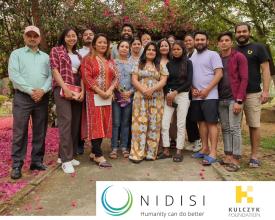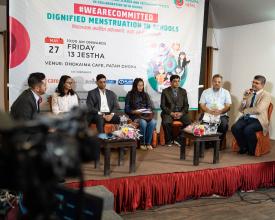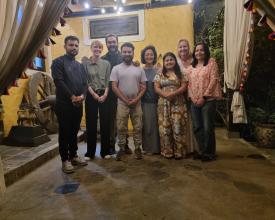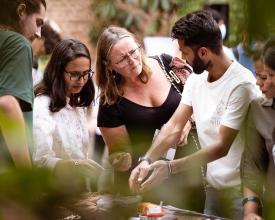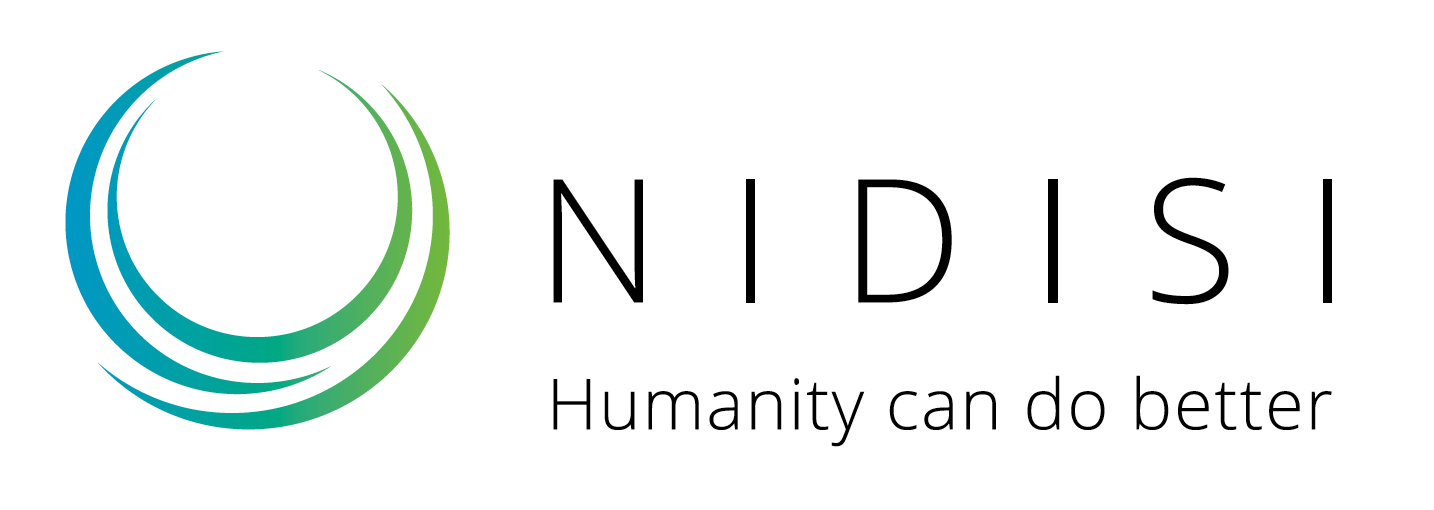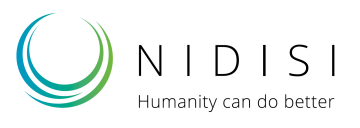
Building networks and relationships to strengthen and promote the compostable menstrual pad production in Nepal
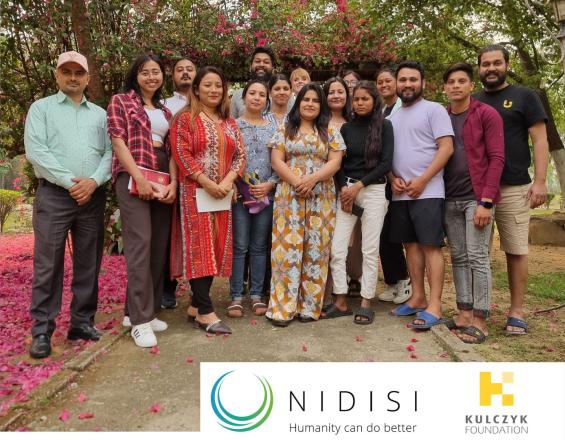
This initiative is part of the Sparsa Solution, a Nepali non-profit organization that locally produces and distributes compostable menstrual pads with an absorbent core made from banana fiber.
To scale impact and ensure sustainability, Sparsa actively builds strong relationships with government bodies, grassroots organizations, and global partners. We engage municipalities, schools, and women-led NGOs to expand awareness, build trust, and ensure our solutions are locally relevant and widely accessible. We are a proud member of the Menstrual Health Management Partner Alliance (MHMPA) Nepal, enabling national-level advocacy and knowledge exchange. By completing all legal steps and aligning with government frameworks, we ensure full compliance and credibility. These partnerships—ranging from policy support to grassroots mobilization—have enabled Sparsa to extend its reach, foster innovation, and integrate menstrual health into broader development goals.
Context
Challenges addressed
Social Challenges:
Navigating power dynamics and stigma around menstruation made it difficult to establish partnerships with schools, communities, and local leaders. Some stakeholders were hesitant to associate publicly with menstrual health initiatives. Building trust required long-term engagement and culturally sensitive approaches.
Economic Challenges:
Public and private partners were sometimes reluctant to collaborate before seeing a market-ready product or clear financial model. Administrative processes such as registration, permits, and product approvals also involved hidden costs and delays, requiring significant time and local insight to manage.
Governance Challenges:
The legal landscape for social enterprises in Nepal is complex. Engaging the right authorities, understanding jurisdictional overlaps, and ensuring full legal compliance—especially while importing materials or formalizing production—presented bureaucratic obstacles that could delay progress if not carefully managed.
Location
Process
Summary of the process
In our case, building strong networks and partnerships depends on three interconnected pillars. First, securing full legal registration and government approvals creates a foundation of trust and operational legitimacy. This legal groundwork is essential for attracting partners and enabling formal collaboration with schools, municipalities, and NGOs.
Second, once the enterprise is legally recognized and insured, it becomes easier to build effective partnerships. These partners help expand reach, tailor messaging to local realities, and support distribution, awareness, and implementation. The stronger the local ties, the more relevant and sustainable the impact.
Third, targeted communication and advocacy reinforce both government relations and grassroots partnerships. By tailoring messages to different audiences—schools, funders, policy actors—Sparsa builds visibility, aligns with national agendas, and reduces menstrual stigma. Clear communication closes the loop: it strengthens trust, attracts new partners, and amplifies impact.
Together, these building blocks reinforce each other and enable scale, resilience, and long-term change.
Building Blocks
Working with Government & Legal Setup
Successfully establishing and scaling a social enterprise like a pad factory requires careful coordination with government authorities and strict compliance with legal requirements. This building block focuses on creating a strong foundation by building trust, ensuring legality, and protecting the enterprise from future risks.
The first step involves informing local and national government bodies about your project plans and activities. Regular communication not only builds transparency and trust but also makes it easier to gain support when needed. It ensures that the enterprise is seen as a responsible and contributing part of the country and community development.
Secondly, it is crucial to coordinate with local or provincial offices to confirm that the factory is located appropriately and meets all zoning, operational, and environmental requirements. Early consultation helps avoid future legal complications and promotes smoother project implementation.
Before any physical construction begins, the enterprise must complete all legal steps, such as securing land use permits, building approvals, and environmental clearances. This process prevents future disputes and ensures that the factory is legally protected at every stage.
If the enterprise plans to import machinery or raw materials from abroad (for example, from India and Chaina), it is essential to follow all import rules, including documentation and tax payments. Compliance with import regulations helps avoid customs delays, penalties, and additional operational costs.
Further, to operate legally in the market, the enterprise must register officially and gain approval to sell its products, such as sanitary pads. Official registration enhances the company’s credibility among customers, partners, and regulatory bodies, opening doors to wider distribution opportunities.
Finally, it is critical to insure the factory, machinery, and assets against potential risks like fire, natural disasters, burglary, or other damages. Having appropriate insurance coverage provides financial protection and ensures business continuity even during unforeseen events.
By following these structured steps, the enterprise not only secures its legal standing but also strengthens its reputation, improves sustainability, and creates a solid platform for growth and social impact.
Enabling factors
Transparent Communication: Early and regular dialogue with government officials builds trust and helps prevent misunderstandings. Keeping authorities informed about your goals, timelines, and challenges encourages them to see your enterprise as a partner, not an outsider.
Clarity on Legal Procedures: Understanding land use laws, construction codes, environmental clearances, and tax requirements is essential. Many social enterprises face delays due to overlooked procedures or changing regulations. Investing time in legal research or consulting with local legal experts prevents costly setbacks.
Local Knowledge and Relationships: Strong ties with local officials, ward representatives, and district offices make it easier to secure permits, resolve issues, and adapt to changing local priorities. Relationships are often more influential than paperwork in moving processes forward.
Early Compliance with Regulations: Completing all legal steps—including registering the enterprise, securing sales approvals, and formalizing land and building use—avoids shutdowns or fines later on. Proactive compliance builds credibility and demonstrates commitment to quality and legality.
Insurance as Risk Mitigation: Covering the factory, machinery, and raw materials against fire, natural disasters, or theft is not only a financial safeguard but also a sign of professionalism. Many donors or government partners view insurance as a marker of organizational maturity.
Flexibility and Patience: Bureaucratic processes in Nepal can be slow and unpredictable. Having flexible timelines and a patient, consistent presence with government staff helps maintain momentum even when delays arise.
Lesson learned
Start Government Communication Early: Engaging with local and national government bodies from the start builds transparency and reduces resistance later. Officials are more likely to support projects they’ve been informed about early.
Hiring Local Staff Builds Legitimacy: Local team members understand the administrative landscape, cultural norms, and informal power dynamics. Their presence facilitates smoother government relations and enhances community trust.
Visit Similar Factories First: Seeing how others operate—especially those working with sanitary pads or similar machinery—helps avoid design flaws, underestimate space needs, or miss critical compliance steps.
Secure and Legalize Land Before Construction: Ensure land ownership or lease agreements are clear, registered, and aligned with zoning laws. This avoids legal disputes and delays during setup.
Plan for Road and Transport Access: Factories must be reachable by road for raw material delivery, machinery transport, and product distribution. Poor access increases costs and reduces efficiency.
Understand Local Regulations in Detail: From building codes to environmental clearances and import duties—every step must comply with national and local laws. Delays often stem from missed details or assumptions.
Expect Bureaucratic Delays in Importing Materials: Importing machinery or raw materials—especially from India—often involves shifting regulations, unclear timelines, and repeated follow-ups. Strong documentation and regular contact with customs officers are essential.
Get Insurance Coverage in Place Early: Insuring the factory and its assets protects against financial losses from fire, burglary, or natural disasters. It also improves your credibility with investors and partners.
Budget for Legal and Administrative Costs: Legal setup involves more than expected—permits, taxes, certifications, and consultations. Having a buffer for these costs prevents interruption in critical phases.
Evaluate Surroundings Carefully: Avoid building too close to sensitive sites like schools or densely populated areas. A peaceful coexistence with neighbors supports long-term operations.
Legal Compliance Unlocks Institutional Partnerships: Government contracts, school distribution, and institutional sales require formal recognition. Being fully registered and approved enables new opportunities and funding.
Collaborative Partnerships for Grassroots Impact
This building block highlights the importance of forming strong, collaborative partnerships to achieve meaningful and sustainable grassroots impact. The success of any social enterprise, especially one focused on menstrual health or community wellbeing, depends not only on the product but also on the strength of the networks that support it.
First, by working closely with local partners (such as municipalities, local NGOs, girls' schools, colleges, hostels, and health centers), you can directly engage with the community. These partners help spread awareness about your product, support outreach activities, and even assist in distribution or sales. They also help ensure that the solutions are tailored to the specific cultural, geographic, and economic needs of the area.
Second, being active in national networks, such as the Menstrual Health Management Partner Alliance (MHMPA) Nepal, allows your project to stay aligned with national goals and current discussions. These networks offer a platform for advocacy, peer learning, joint campaigns, and collective problem-solving, enabling you to scale your impact beyond your immediate locality.
Third, building global partnerships opens the door to shared learning and innovation. For example, learning from other initiatives, such as the banana fiber pad project in Cameroon, can help you avoid common mistakes, adopt better technology, and improve your operations through exposure to diverse approaches.
Finally, teaming up with women’s rights organizations is crucial, especially when addressing issues such as menstrual health. These organizations already have strong community relationships, experience in gender-based advocacy, and a trusted presence in the field. Collaborating with them helps you access the right audience more effectively and lends greater legitimacy to your work.
Together, these partnerships enable your enterprise to grow stronger, gain trust, improve outreach, and build long-term sustainability.
Enabling factors
Trust and Credibility at Local Level: Genuine relationships with community actors foster acceptance, feedback, and co-ownership of the initiative.
Two-Way Communication Across All Levels: From ward officials to schoolteachers and health workers—engagement must include all voices. Listening to feedback from every level strengthens design and delivery.
Shared Vision, Locally Rooted: While national networks offer policy guidance, it's local actors who turn ideas into action. Aligning purpose at every level helps keep goals grounded and achievable.
Embedded Local Presence: Having team members based in communities builds daily visibility and enables quick, culturally informed adjustments.
Network Participation for Visibility and Resources: Being part of national and global platforms opens doors for knowledge sharing, joint advocacy, and funding.
Mutual Benefit and Respect: Partnerships must be reciprocal. Whether it’s visibility, training, or shared tools, each actor should benefit from the collaboration.
Supportive Legal Framework: Legal registration and operational approvals make it possible to formally engage with schools, municipalities, and institutional partners.
Lesson learned
Start by Listening to Local Actors: Health workers, teachers, ward officials, and community leaders bring grounded knowledge of social norms, barriers, and opportunities. Gathering perspectives across all operational levels builds a clearer picture of the landscape, leading to better-informed decisions and more effective design.
Community Engagement Builds Ownership: When local stakeholders are involved in decision-making—not just implementation—solutions gain legitimacy, traction, and long-term support. It takes time, but that investment pays off. People are more likely to champion the work and even take on responsibilities when they feel their input genuinely shapes the outcome.
Partnerships Multiply Reach and Relevance: Working with NGOs, schools, and health posts expands your impact and ensures that interventions reflect local realities. These partnerships don’t just support delivery—they open space for dialogue. Through regular exchange, new ideas emerge, unexpected opportunities arise, and your approach stays responsive to real needs.
Trust Is Slow but Foundational: Local trust is built through presence, follow-through, and consistency—not one-off meetings. It also depends on information flow: partners need time to learn about each other’s goals, values, and working styles. Only with that mutual understanding can genuine, lasting collaboration take root.
Tailor Communication to the Audience: Different levels of partners require different approaches—from informal conversations to formal MOUs. A clear communication strategy helps ensure the right tone, tools, and timing. Each partner is different, and taking time to understand their expectations and preferred ways of working allows for more effective, respectful collaboration.
Be Transparent About the Project Stage: If you're still prototyping, say so. Honesty earns respect—even when things aren’t perfect. Being open about key challenges builds credibility and trust. It invites dialogue, creates space for joint problem-solving, and helps manage expectations among partners and stakeholders.
Co-creation Outperforms Top-Down Models: Collaborative design takes time, but it leads to stronger partnerships, deeper user ownership, and better outcomes. When community members and local partners help shape the process from the beginning—not just implement it—they’re more invested and more likely to stand by the work long-term. Co-creation surfaces insights that top-down approaches often miss, and it builds mutual accountability that strengthens resilience when challenges arise.
Women’s Organizations Amplify Impact: These groups bring deep community roots, lived experience, and credibility—especially when working on sensitive topics like menstruation. Their networks open doors that others can’t, and their long-standing presence builds trust faster. Collaborating with women-led or women-focused organizations strengthens outreach, ensures gender-sensitive approaches, and adds critical insight to both program design and advocacy.
Global Learning Adds Value, Not Blueprinting: Engaging with global peers offers inspiration, shared strategies, and insight into what works elsewhere—but direct replication rarely fits. Local realities vary, and blindly applying external models can lead to failure or rejection. Instead, meaningful learning comes from adapting global lessons to your specific context, guided by local knowledge and needs.
National Networks Are Catalysts for Alignment: Being active in national platforms (like MHMPA Nepal) connects your work to policy dialogues, strengthens your credibility, and creates opportunities for joint campaigns, learning, and influence. These networks help keep the project relevant and resilient within a shifting national context.
Strengthening Communication and Advocacy for Women's Health and Rights
This building block focuses on communication and advocacy as essential tools for creating systemic change—not just spreading information. Menstrual health is deeply personal but also shaped by institutional silence, stigma, and policy neglect. To challenge these patterns, the way we communicate must be intentional, inclusive, and tailored to each audience.
We develop distinct strategies for different stakeholders: government actors require policy-aligned framing and formal presentations; schools and youth respond better to creative, interactive materials; funders seek clarity, evidence, and long-term potential. Understanding what matters to each group—and delivering it in their language—has been key.
At the same time, we frame menstrual health as part of larger social goals: education, gender equality, environmental sustainability, and health equity. This framing helps broaden the base of support, positioning the issue within mainstream development agendas and attracting allies beyond the menstrual health space.
Advocacy happens through both formal and informal channels. While we participate in national alliances like MHMPA Nepal to shape policy and coordinate campaigns, we also invest in everyday conversations with local leaders, NGOs, and school staff. In both spaces, trust and consistency matter as much as messaging.
Strong communication gives menstrual health a visible, legitimate place in public life. It opens doors to new partnerships, mobilizes communities, and helps dismantle the silence that sustains discrimination.
Enabling factors
Audience-Centered Strategy:Effective communication starts with understanding your audience—what they care about, how they process information, and what motivates them. Tailoring messages to these needs increases engagement and reduces resistance.
Trusted Local Messengers: Messages are more impactful when delivered by people the community already knows and respects—such as teachers, nurses, or local leaders. These messengers help bridge gaps of language, trust, and authority.
Framing Within Broader Agendas:Linking menstrual health to national priorities like education, gender equity, and environmental protection helps position it as a shared development goal, not a niche issue.
Clarity and Consistency: Maintaining a clear mission, unified voice, and visual identity across all materials and channels builds brand trust and recognition—especially important when working with multiple partners.
Presence at Multiple Levels: Being visible at local, municipal, and national levels creates reinforcement and allows the message to travel more effectively across different parts of the system.
Use of Storytelling and Visual Media:Creative communication tools—videos, graphics, real-life stories—help translate complex or taboo topics into emotionally resonant and relatable messages.
Bilingual and Culturally Relevant Materials: Developing materials in local languages and formats ensures accessibility and inclusion, especially in rural or underserved areas.
Safe Spaces for Dialogue: Creating informal and non-judgmental settings—such as school clubs, community groups, or tea-break conversations—encourages open discussions and reduces shame.
Lesson learned
Tailor Your Approach to the Audience: What works for students won’t work for government officials. Each group requires different messaging, tone, and format. Customizing your approach shows respect and improves results.
Clarity in Mission Strengthens Partnerships: When your message is clear and consistent, people understand what you stand for and how they can contribute. This clarity helps build s3tronger, more aligned collaborations.
Start with Trusted Local Connections: Partnering with locally embedded actors—such as NGOs, nurses, or teachers—helps deliver your message through trusted channels and speeds up acceptance.
Informal Touchpoints Build Stronger Ties: Some of the most important conversations don’t happen in meetings. Informal chats, community visits, and shared moments build trust that formal settings often can’t.
Be Transparent—Including About Challenges: Sharing ongoing obstacles (not just successes) increases credibility, invites support, and helps partners adjust expectations. People are more willing to help when they see honesty.
Strong Communication Attracts Allies: Well-crafted materials and a compelling narrative not only help change minds—they attract donors, institutions, and volunteers who resonate with your cause.
Women-Led Voices Strengthen Legitimacy: Including women—especially those directly affected—in messaging and delivery increases authenticity, trust, and relevance.
Consistency Builds Identity: Using consistent language, visual style, and values across all channels creates a recognizable identity and strengthens your organization's public image.
Two-Way Communication Improves Outcomes: Listening is as important as speaking. Actively seeking feedback from the community and partners helps refine your messaging and makes people feel heard.
Situating Menstrual Health in Broader Narratives Helps: Framing your work within broader agendas—like education, youth empowerment, or climate resilience—makes it more relatable and easier for others to support.
Impacts
Social impact: Our relationships with schools, municipalities, and local NGOs enabled menstrual health education sessions across multiple districts, reaching students, teachers, and community leaders. These sessions helped reduce stigma, increase knowledge, and normalize conversations around menstruation—especially among youth. Women’s rights organizations became long-term partners in outreach, helping tailor messaging to local needs and supporting advocacy efforts for improved menstrual health policy.
Economic impact: By securing full legal registration and government approvals, we established ourselves as a credible partner in the eyes of both public institutions and donors. This legitimacy unlocked funding opportunities and facilitated product distribution in schools and municipalities. Local partnerships enabled cost-efficient pad delivery and created income-generating roles for women in production, sales, and training.
Environmental impact: Our advocacy and communications have helped shift institutional awareness toward sustainable menstrual products. Through direct engagement with government and national networks like MHMPA, we have influenced conversations on environmentally friendly procurement and waste management in menstrual health programming, contributing to longer-term policy alignment.
Beneficiaries
Local governments gained trusted partners for awareness and pad distribution. Schools and NGOs accessed materials and support. Women and girls benefited from stigma reduction and access to safe products. Local staff gained employment and skills.
Global Biodiversity Framework (GBF)
Sustainable Development Goals
Story
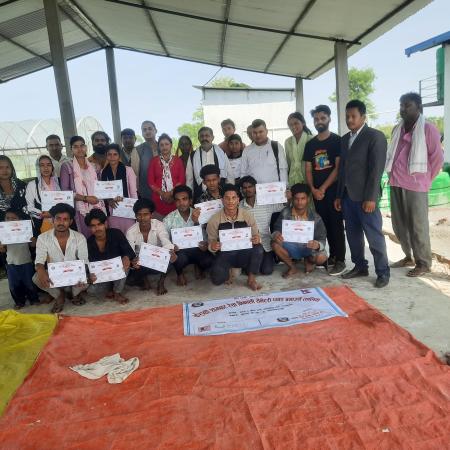
Empowering Local Farmers Through Collaboration in Susta
In the heart of Susta, Sparsa Nepal has been running a fiber factory that produces high-quality banana fiber using agricultural waste. Over the past year, our trained operators have gained valuable expertise in fiber extraction, operating machinery, and maintaining efficient, eco-friendly production.
Our commitment to community engagement and regular communication with the local government has created a strong foundation of trust and partnership. As a registered enterprise at the Department of Industry (DOI) in Parasi, our work caught the attention of DOI officials, who recognized the growing potential of banana fiber as a sustainable resource for income generation.
In early 2025, the DOI in Parasi approached us with an exciting opportunity—they wanted to train local farmers in fiber extraction from banana trunks. With our operational factory, experienced team, and complete set of fiber processing machinery already in place, Sparsa Nepal was the ideal partner.
We enthusiastically collaborated with the DOI to conduct hands-on training sessions for local farmers right at our factory in Susta. Our trained operators led the sessions, guiding the farmers step by step on how to extract and process banana fiber using our equipment.
In addition to fiber training, we also introduced the farmers to composting techniques using the leftover banana waste. This initiative aimed to reduce environmental impact while promoting organic farming practices. Farmers were trained to create compost that could be used as a natural, chemical-free fertilizer in their fields—supporting healthier crops and long-term soil fertility.
This partnership was a win-win: local farmers gained practical skills that diversified their income and reduced dependence on chemical inputs, and Sparsa was able to strengthen its role as a community-centered enterprise driving sustainable development. The successful collaboration has not only expanded local capacity but also deepened our connection with the community and government stakeholders.
This story stands as a proud example of what can be achieved through meaningful collaboration, local empowerment, and a shared vision for sustainability.

